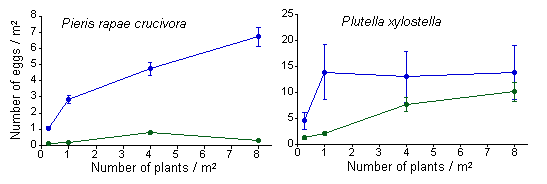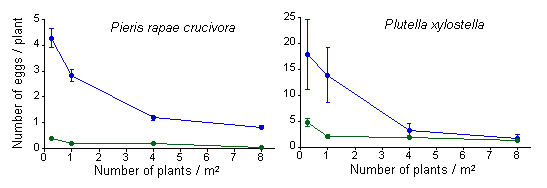The relationship between plant density and the abundance of arthropods
was examined by planting cabbages in four densities (0.25, 1, 4, 8 plants per
square meter). Four herbivorous species were examined: the small white butterfly Pieris rapae crucivora Boisduval,
the diamondback moth Plutella xylostella (Linnaeus), the beet semi-looper Autographa nigrisigna (Walker),
and the
green peach aphid Myzus persicae (Sulzer). The number of spiders and the
number of eggs of syrphid flies were also examined. The number of individuals
per unit ground area curvilinearly increased with increasing plant density for
most arthropods. To clarify the mechanism causing such a curvilinear increase,
the oviposition behavior of P. rapae crucivora was examined. The oviposition
process
of a female was divided into three components: (1) entering the field, (2) alighting
on a plant to bend her abdomen, and (3) attaching an egg on the leaf. The first
and the second components curvilinearly increased with increasing plant density,
while the third component was not influenced by the plant density. The analysis
of the flight path of P. rapae crucivora indicated that the curvilinear increase
in the frequency of abdominal bending behaviors occurs since a female flies at
least about 1.3m between successive abdominal bending behaviors irrespective
of
the plant density when the plant density is sufficiently high. (Copyright by
the
Society of Population Ecology and Springer-Verlag Tokyo)

Figure 1. Effects of plant density on the number of herbivores per unit
ground area (m2). Vertical bars indicate asymptotic standard
errors. The number of eggs per unit area increases with increasing plant density.
(Copyright by the Society of Population Ecology and Springer-Verlag Tokyo)

Figure 2. Effects of plant density on the number of herbivores per plant.
Vertical bars indicate asymptotic standard errors. The number of eggs per plant
decreases with increasing plant density. (Copyright by the Society of Population
Ecology and Springer-Verlag Tokyo)